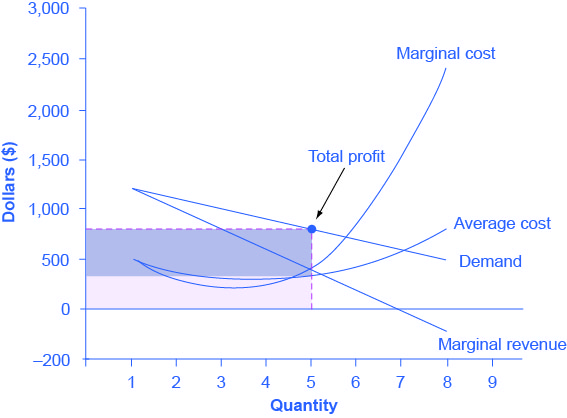11.18: Computing Monopoly Profits
- Page ID
- 48435
Learning Objectives
- Illustrate a monopoly’s profits on a graph
It is straightforward to calculate profits of given numbers for total revenue and total cost. However, the size of monopoly profits can also be illustrated graphically with Figure 1, which takes the marginal cost and marginal revenue curves from the previous exhibit and adds an average cost curve and the monopolist’s perceived demand curve.

The three-step process where a monopolist selects the profit-maximizing quantity to produce, decides what price to charge, and then determines total revenue, total cost and profit. These steps include:
Step 1: The Monopolist Determines Its Profit-Maximizing Level of Output
Since each point on a demand curve shows price and quantity, the firm can use the points on the demand curve D to calculate total revenue, and then, based on total revenue, calculate its marginal revenue curve. The profit-maximizing quantity will occur where MR = MC—or at the last possible point before marginal costs start exceeding marginal revenue. On Figure 1, MR = MC occurs at an output of 5.
Step 2: The Monopolist Decides What Price to Charge
The monopolist will charge what the market is willing to pay. A dotted line drawn straight up from the profit-maximizing quantity to the demand curve shows the profit-maximizing price which, in Figure 1, is $800. This price is above the average cost curve, which shows that the firm is earning profits.
Step 3: Calculate Total Revenue, Total Cost, and Profit
Total revenue is the overall shaded box, where the width of the box is the quantity sold and the height is the price. In Figure 1, this is 5 x $800 = $4000. The bottom part of the shaded box, which is shaded more lightly, shows total costs; that is, quantity on the horizontal axis multiplied by average cost on the vertical axis or 5 x $330 = $1650. The larger box of total revenues minus the smaller box of total costs will equal profits, which the darkly shaded box shows. Using the numbers gives $4000 – $1650 = $2350. In a perfectly competitive market, the forces of entry would erode this profit in the long run. However, a monopolist is protected by barriers to entry. In fact, one obvious sign of a possible monopoly is when a firm earns profits year after year, while doing more or less the same thing, without ever seeing increased competition eroding those profits.
An interactive or media element has been excluded from this version of the text. You can view it online here: http://pb.libretexts.org/mecon/?p=370
In a perfectly competitive market, the forces of entry would erode this profit in the long run. But a monopolist is protected by barriers to entry. In fact, one telltale sign of a possible monopoly is when a firm earns profits year after year, while doing more or less the same thing, without ever seeing those profits eroded by increased competition.
Watch It
Let’s apply these concepts to a problem. Watch the video to walk through the steps of finding total profit for a monopolist under the following conditions:
Demand: P = 100 – 2q
Fixed cost: 100
Marginal cost: 20
An interactive or media element has been excluded from this version of the text. You can view it online here: http://pb.libretexts.org/mecon/?p=370
These are the steps to find total profit when presented with information about the demand curve:
- First find the marginal revenue. Remember that when working with a linear demand curve, you can double the slope of the demand curve to find the slope of the marginal revenue curve.
- Set marginal revenue equal to marginal cost in order to find quantity. You can use the information given to set the new marginal revenue curve equal to marginal cost (ie. 100 – 4Q = 20).
- Use the quantity to find the price. Now that you have the quantity, you can plug that into the original demand curve to solve for the price.
- Find total revenue and total cost. Total cost is fixed costs plus variable costs. Total revenue is the quantity times the price.
- Solve for profit by subtracting the total cost from the total revenue.
Try It
These questions allow you to get as much practice as you need, as you can click the link at the top of the first question (“Try another version of these questions”) to get a new set of questions. Practice until you feel comfortable doing the questions.
[ohm_question]155042-155057[/ohm_question]
- Modification, adaptation, and original content. Provided by: Lumen Learning. License: CC BY: Attribution
- How a Profit-Maximizing Monopoly Chooses Output and Price. Authored by: OpenStax College. Located at: https://cnx.org/contents/vEmOH-_p@4.40:nZyOdEt7@4/How-a-Profit-Maximizing-Monopo#CNX_Econ_C09_006. License: CC BY: Attribution. License Terms: Download for free at http://cnx.org/contents/bc498e1f-efe...569ad09a82@4.4
- Office Hours: Calculating Monopoly Profit. Provided by: Marginal Revolution University. Located at: https://www.youtube.com/watch?time_continue=93&v=FiQsdBWEaMI. License: Other. License Terms: Standard YouTube License

